Activity Plan for Literacy Development
VerifiedAdded on 2023/04/06
|9
|2555
|388
AI Summary
This activity plan focuses on engaging children in a kitchen activity to improve their creative and literary skills. It involves decorating an old chef cap with colorful sketch pens and stickers, helping children become familiar with alphabets, colors, and their own names. The activity also promotes fine motor skills and hand-eye coordination. Suitable for 24-month-old children.
Contribute Materials
Your contribution can guide someone’s learning journey. Share your
documents today.
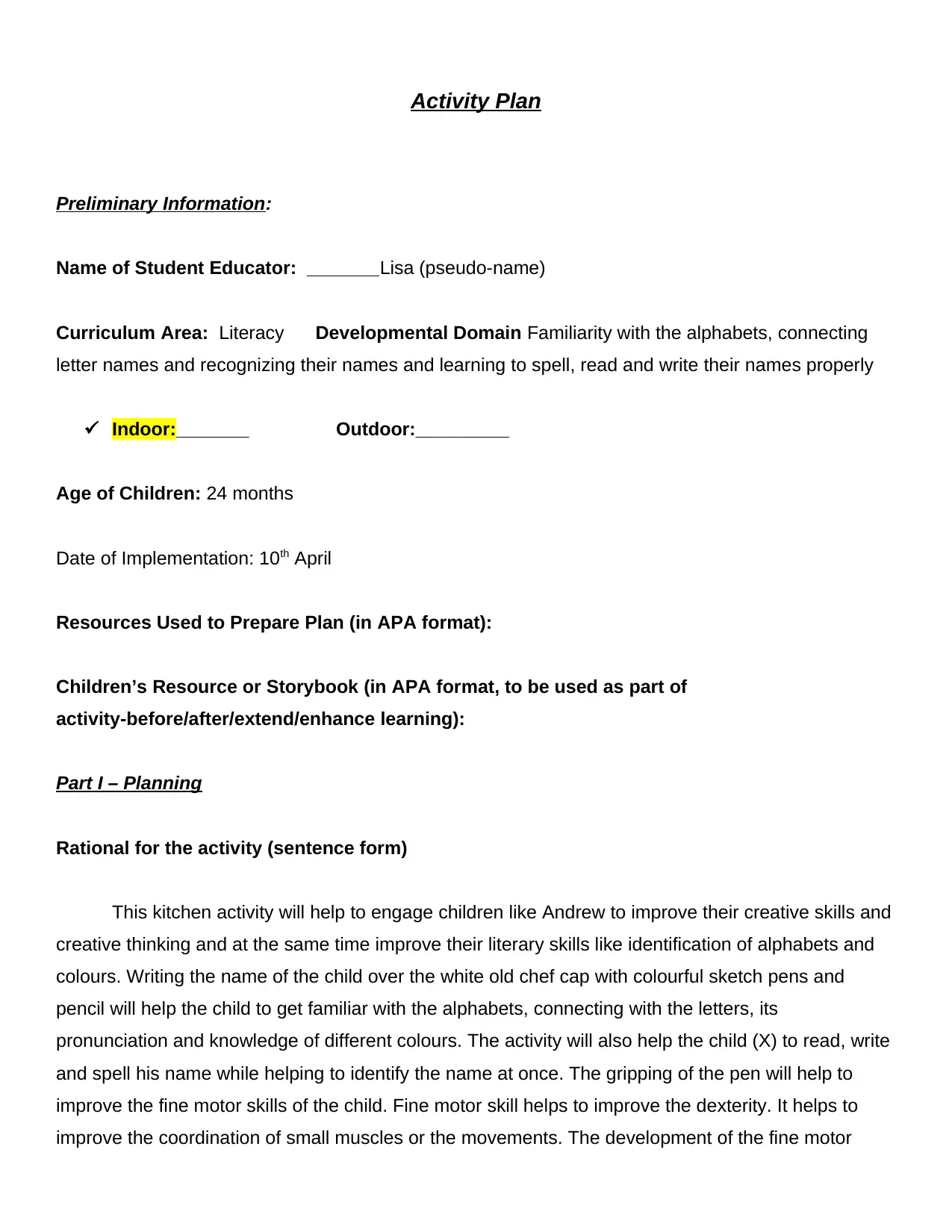
Activity Plan
Preliminary Information:
Name of Student Educator: _______Lisa (pseudo-name)
Curriculum Area: Literacy Developmental Domain Familiarity with the alphabets, connecting
letter names and recognizing their names and learning to spell, read and write their names properly
Indoor:_______ Outdoor:_________
Age of Children: 24 months
Date of Implementation: 10th April
Resources Used to Prepare Plan (in APA format):
Children’s Resource or Storybook (in APA format, to be used as part of
activity-before/after/extend/enhance learning):
Part I – Planning
Rational for the activity (sentence form)
This kitchen activity will help to engage children like Andrew to improve their creative skills and
creative thinking and at the same time improve their literary skills like identification of alphabets and
colours. Writing the name of the child over the white old chef cap with colourful sketch pens and
pencil will help the child to get familiar with the alphabets, connecting with the letters, its
pronunciation and knowledge of different colours. The activity will also help the child (X) to read, write
and spell his name while helping to identify the name at once. The gripping of the pen will help to
improve the fine motor skills of the child. Fine motor skill helps to improve the dexterity. It helps to
improve the coordination of small muscles or the movements. The development of the fine motor
Preliminary Information:
Name of Student Educator: _______Lisa (pseudo-name)
Curriculum Area: Literacy Developmental Domain Familiarity with the alphabets, connecting
letter names and recognizing their names and learning to spell, read and write their names properly
Indoor:_______ Outdoor:_________
Age of Children: 24 months
Date of Implementation: 10th April
Resources Used to Prepare Plan (in APA format):
Children’s Resource or Storybook (in APA format, to be used as part of
activity-before/after/extend/enhance learning):
Part I – Planning
Rational for the activity (sentence form)
This kitchen activity will help to engage children like Andrew to improve their creative skills and
creative thinking and at the same time improve their literary skills like identification of alphabets and
colours. Writing the name of the child over the white old chef cap with colourful sketch pens and
pencil will help the child to get familiar with the alphabets, connecting with the letters, its
pronunciation and knowledge of different colours. The activity will also help the child (X) to read, write
and spell his name while helping to identify the name at once. The gripping of the pen will help to
improve the fine motor skills of the child. Fine motor skill helps to improve the dexterity. It helps to
improve the coordination of small muscles or the movements. The development of the fine motor
Secure Best Marks with AI Grader
Need help grading? Try our AI Grader for instant feedback on your assignments.
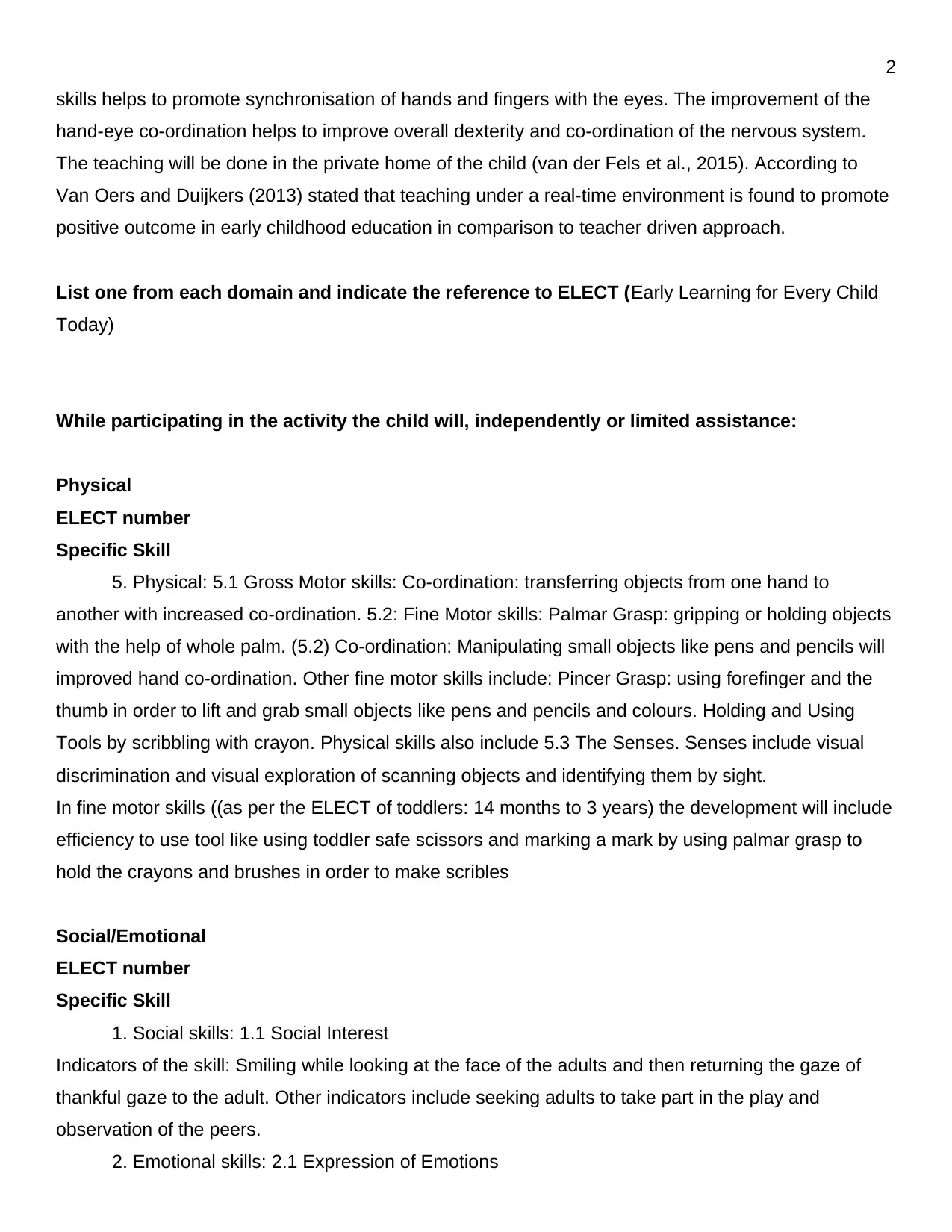
skills helps to promote synchronisation of hands and fingers with the eyes. The improvement of the
hand-eye co-ordination helps to improve overall dexterity and co-ordination of the nervous system.
The teaching will be done in the private home of the child (van der Fels et al., 2015). According to
Van Oers and Duijkers (2013) stated that teaching under a real-time environment is found to promote
positive outcome in early childhood education in comparison to teacher driven approach.
List one from each domain and indicate the reference to ELECT (Early Learning for Every Child
Today)
While participating in the activity the child will, independently or limited assistance:
Physical
ELECT number
Specific Skill
5. Physical: 5.1 Gross Motor skills: Co-ordination: transferring objects from one hand to
another with increased co-ordination. 5.2: Fine Motor skills: Palmar Grasp: gripping or holding objects
with the help of whole palm. (5.2) Co-ordination: Manipulating small objects like pens and pencils will
improved hand co-ordination. Other fine motor skills include: Pincer Grasp: using forefinger and the
thumb in order to lift and grab small objects like pens and pencils and colours. Holding and Using
Tools by scribbling with crayon. Physical skills also include 5.3 The Senses. Senses include visual
discrimination and visual exploration of scanning objects and identifying them by sight.
In fine motor skills ((as per the ELECT of toddlers: 14 months to 3 years) the development will include
efficiency to use tool like using toddler safe scissors and marking a mark by using palmar grasp to
hold the crayons and brushes in order to make scribles
Social/Emotional
ELECT number
Specific Skill
1. Social skills: 1.1 Social Interest
Indicators of the skill: Smiling while looking at the face of the adults and then returning the gaze of
thankful gaze to the adult. Other indicators include seeking adults to take part in the play and
observation of the peers.
2. Emotional skills: 2.1 Expression of Emotions
2
hand-eye co-ordination helps to improve overall dexterity and co-ordination of the nervous system.
The teaching will be done in the private home of the child (van der Fels et al., 2015). According to
Van Oers and Duijkers (2013) stated that teaching under a real-time environment is found to promote
positive outcome in early childhood education in comparison to teacher driven approach.
List one from each domain and indicate the reference to ELECT (Early Learning for Every Child
Today)
While participating in the activity the child will, independently or limited assistance:
Physical
ELECT number
Specific Skill
5. Physical: 5.1 Gross Motor skills: Co-ordination: transferring objects from one hand to
another with increased co-ordination. 5.2: Fine Motor skills: Palmar Grasp: gripping or holding objects
with the help of whole palm. (5.2) Co-ordination: Manipulating small objects like pens and pencils will
improved hand co-ordination. Other fine motor skills include: Pincer Grasp: using forefinger and the
thumb in order to lift and grab small objects like pens and pencils and colours. Holding and Using
Tools by scribbling with crayon. Physical skills also include 5.3 The Senses. Senses include visual
discrimination and visual exploration of scanning objects and identifying them by sight.
In fine motor skills ((as per the ELECT of toddlers: 14 months to 3 years) the development will include
efficiency to use tool like using toddler safe scissors and marking a mark by using palmar grasp to
hold the crayons and brushes in order to make scribles
Social/Emotional
ELECT number
Specific Skill
1. Social skills: 1.1 Social Interest
Indicators of the skill: Smiling while looking at the face of the adults and then returning the gaze of
thankful gaze to the adult. Other indicators include seeking adults to take part in the play and
observation of the peers.
2. Emotional skills: 2.1 Expression of Emotions
2
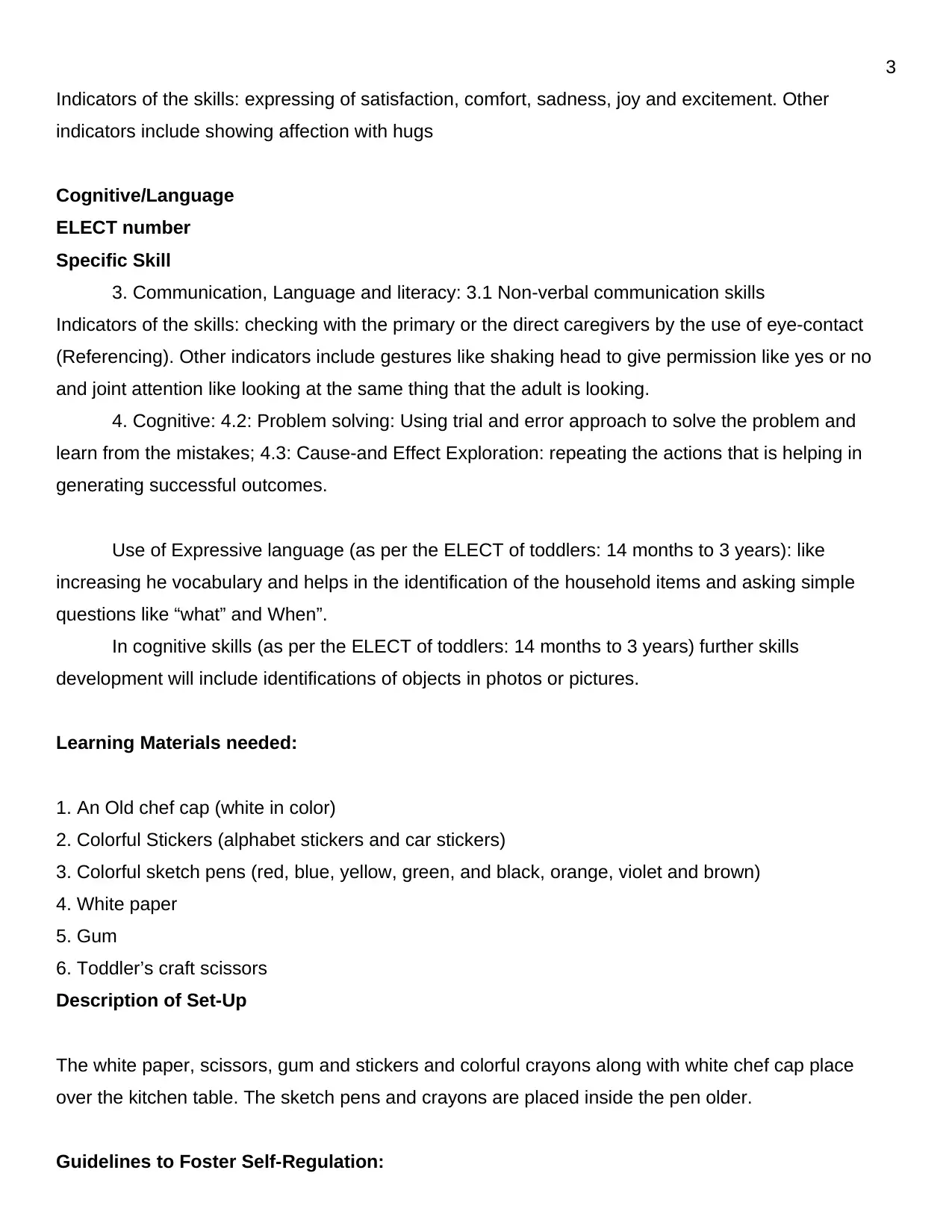
Indicators of the skills: expressing of satisfaction, comfort, sadness, joy and excitement. Other
indicators include showing affection with hugs
Cognitive/Language
ELECT number
Specific Skill
3. Communication, Language and literacy: 3.1 Non-verbal communication skills
Indicators of the skills: checking with the primary or the direct caregivers by the use of eye-contact
(Referencing). Other indicators include gestures like shaking head to give permission like yes or no
and joint attention like looking at the same thing that the adult is looking.
4. Cognitive: 4.2: Problem solving: Using trial and error approach to solve the problem and
learn from the mistakes; 4.3: Cause-and Effect Exploration: repeating the actions that is helping in
generating successful outcomes.
Use of Expressive language (as per the ELECT of toddlers: 14 months to 3 years): like
increasing he vocabulary and helps in the identification of the household items and asking simple
questions like “what” and When”.
In cognitive skills (as per the ELECT of toddlers: 14 months to 3 years) further skills
development will include identifications of objects in photos or pictures.
Learning Materials needed:
1. An Old chef cap (white in color)
2. Colorful Stickers (alphabet stickers and car stickers)
3. Colorful sketch pens (red, blue, yellow, green, and black, orange, violet and brown)
4. White paper
5. Gum
6. Toddler’s craft scissors
Description of Set-Up
The white paper, scissors, gum and stickers and colorful crayons along with white chef cap place
over the kitchen table. The sketch pens and crayons are placed inside the pen older.
Guidelines to Foster Self-Regulation:
3
indicators include showing affection with hugs
Cognitive/Language
ELECT number
Specific Skill
3. Communication, Language and literacy: 3.1 Non-verbal communication skills
Indicators of the skills: checking with the primary or the direct caregivers by the use of eye-contact
(Referencing). Other indicators include gestures like shaking head to give permission like yes or no
and joint attention like looking at the same thing that the adult is looking.
4. Cognitive: 4.2: Problem solving: Using trial and error approach to solve the problem and
learn from the mistakes; 4.3: Cause-and Effect Exploration: repeating the actions that is helping in
generating successful outcomes.
Use of Expressive language (as per the ELECT of toddlers: 14 months to 3 years): like
increasing he vocabulary and helps in the identification of the household items and asking simple
questions like “what” and When”.
In cognitive skills (as per the ELECT of toddlers: 14 months to 3 years) further skills
development will include identifications of objects in photos or pictures.
Learning Materials needed:
1. An Old chef cap (white in color)
2. Colorful Stickers (alphabet stickers and car stickers)
3. Colorful sketch pens (red, blue, yellow, green, and black, orange, violet and brown)
4. White paper
5. Gum
6. Toddler’s craft scissors
Description of Set-Up
The white paper, scissors, gum and stickers and colorful crayons along with white chef cap place
over the kitchen table. The sketch pens and crayons are placed inside the pen older.
Guidelines to Foster Self-Regulation:
3
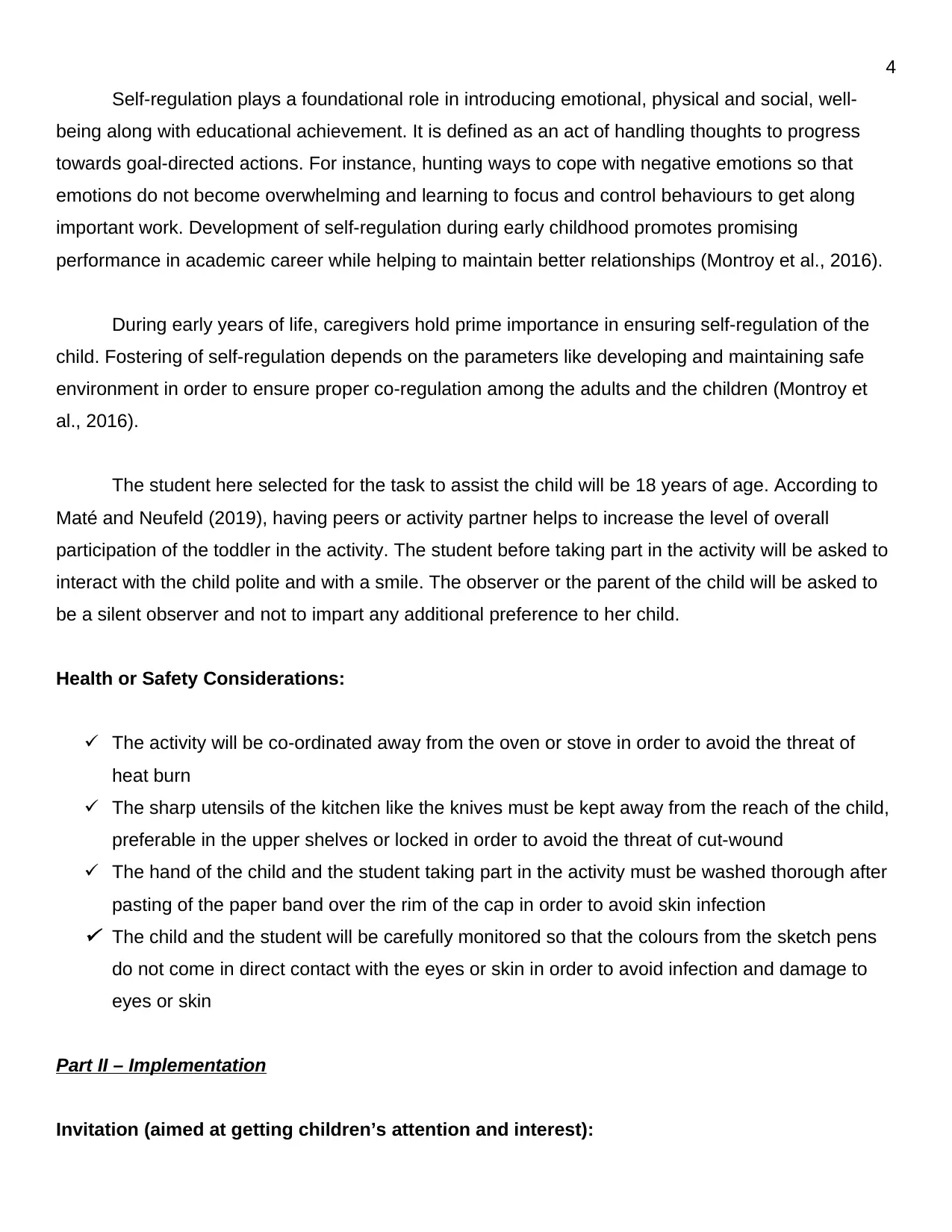
Self-regulation plays a foundational role in introducing emotional, physical and social, well-
being along with educational achievement. It is defined as an act of handling thoughts to progress
towards goal-directed actions. For instance, hunting ways to cope with negative emotions so that
emotions do not become overwhelming and learning to focus and control behaviours to get along
important work. Development of self-regulation during early childhood promotes promising
performance in academic career while helping to maintain better relationships (Montroy et al., 2016).
During early years of life, caregivers hold prime importance in ensuring self-regulation of the
child. Fostering of self-regulation depends on the parameters like developing and maintaining safe
environment in order to ensure proper co-regulation among the adults and the children (Montroy et
al., 2016).
The student here selected for the task to assist the child will be 18 years of age. According to
Maté and Neufeld (2019), having peers or activity partner helps to increase the level of overall
participation of the toddler in the activity. The student before taking part in the activity will be asked to
interact with the child polite and with a smile. The observer or the parent of the child will be asked to
be a silent observer and not to impart any additional preference to her child.
Health or Safety Considerations:
The activity will be co-ordinated away from the oven or stove in order to avoid the threat of
heat burn
The sharp utensils of the kitchen like the knives must be kept away from the reach of the child,
preferable in the upper shelves or locked in order to avoid the threat of cut-wound
The hand of the child and the student taking part in the activity must be washed thorough after
pasting of the paper band over the rim of the cap in order to avoid skin infection
The child and the student will be carefully monitored so that the colours from the sketch pens
do not come in direct contact with the eyes or skin in order to avoid infection and damage to
eyes or skin
Part II – Implementation
Invitation (aimed at getting children’s attention and interest):
4
being along with educational achievement. It is defined as an act of handling thoughts to progress
towards goal-directed actions. For instance, hunting ways to cope with negative emotions so that
emotions do not become overwhelming and learning to focus and control behaviours to get along
important work. Development of self-regulation during early childhood promotes promising
performance in academic career while helping to maintain better relationships (Montroy et al., 2016).
During early years of life, caregivers hold prime importance in ensuring self-regulation of the
child. Fostering of self-regulation depends on the parameters like developing and maintaining safe
environment in order to ensure proper co-regulation among the adults and the children (Montroy et
al., 2016).
The student here selected for the task to assist the child will be 18 years of age. According to
Maté and Neufeld (2019), having peers or activity partner helps to increase the level of overall
participation of the toddler in the activity. The student before taking part in the activity will be asked to
interact with the child polite and with a smile. The observer or the parent of the child will be asked to
be a silent observer and not to impart any additional preference to her child.
Health or Safety Considerations:
The activity will be co-ordinated away from the oven or stove in order to avoid the threat of
heat burn
The sharp utensils of the kitchen like the knives must be kept away from the reach of the child,
preferable in the upper shelves or locked in order to avoid the threat of cut-wound
The hand of the child and the student taking part in the activity must be washed thorough after
pasting of the paper band over the rim of the cap in order to avoid skin infection
The child and the student will be carefully monitored so that the colours from the sketch pens
do not come in direct contact with the eyes or skin in order to avoid infection and damage to
eyes or skin
Part II – Implementation
Invitation (aimed at getting children’s attention and interest):
4
Secure Best Marks with AI Grader
Need help grading? Try our AI Grader for instant feedback on your assignments.
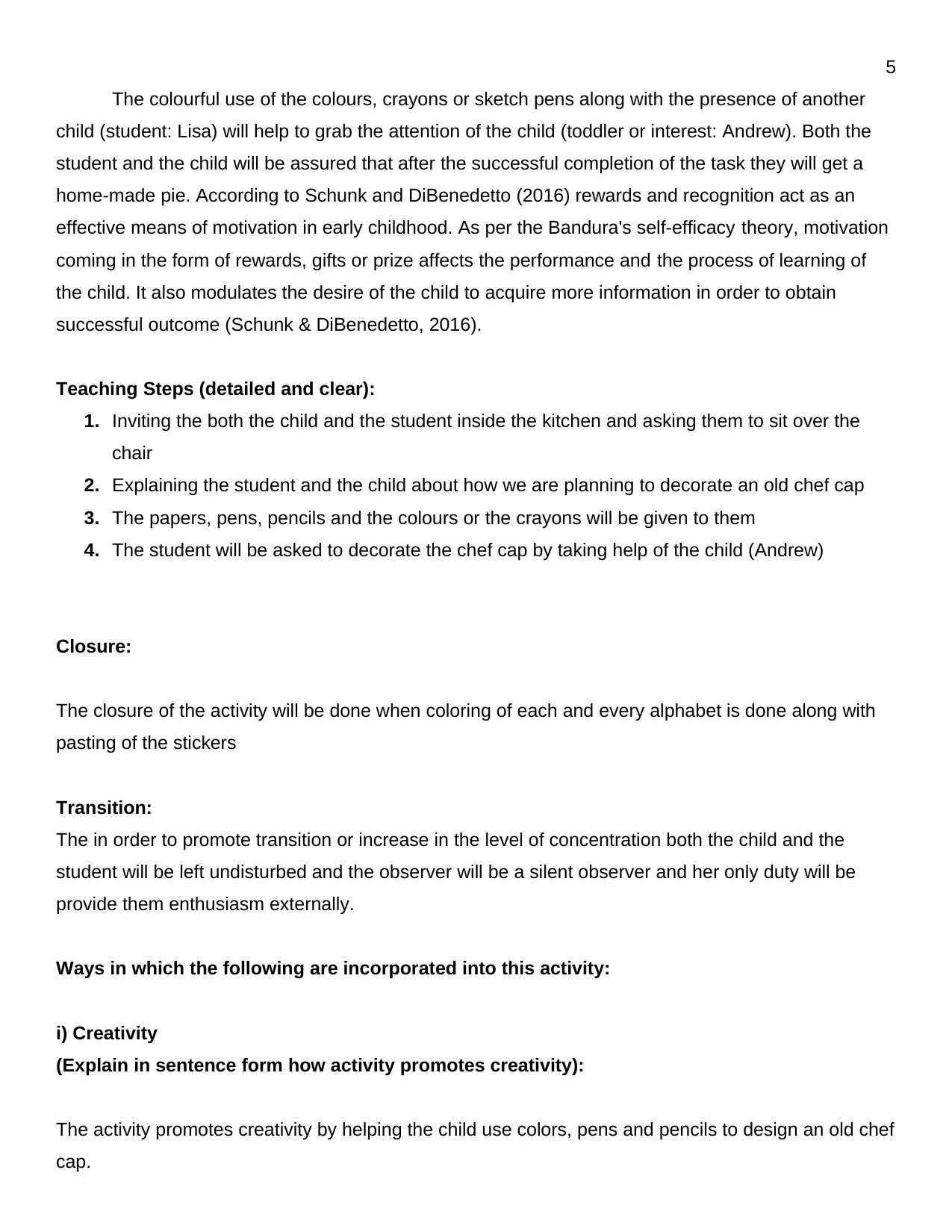
The colourful use of the colours, crayons or sketch pens along with the presence of another
child (student: Lisa) will help to grab the attention of the child (toddler or interest: Andrew). Both the
student and the child will be assured that after the successful completion of the task they will get a
home-made pie. According to Schunk and DiBenedetto (2016) rewards and recognition act as an
effective means of motivation in early childhood. As per the Bandura's self-efficacy theory, motivation
coming in the form of rewards, gifts or prize affects the performance and the process of learning of
the child. It also modulates the desire of the child to acquire more information in order to obtain
successful outcome (Schunk & DiBenedetto, 2016).
Teaching Steps (detailed and clear):
1. Inviting the both the child and the student inside the kitchen and asking them to sit over the
chair
2. Explaining the student and the child about how we are planning to decorate an old chef cap
3. The papers, pens, pencils and the colours or the crayons will be given to them
4. The student will be asked to decorate the chef cap by taking help of the child (Andrew)
Closure:
The closure of the activity will be done when coloring of each and every alphabet is done along with
pasting of the stickers
Transition:
The in order to promote transition or increase in the level of concentration both the child and the
student will be left undisturbed and the observer will be a silent observer and her only duty will be
provide them enthusiasm externally.
Ways in which the following are incorporated into this activity:
i) Creativity
(Explain in sentence form how activity promotes creativity):
The activity promotes creativity by helping the child use colors, pens and pencils to design an old chef
cap.
5
child (student: Lisa) will help to grab the attention of the child (toddler or interest: Andrew). Both the
student and the child will be assured that after the successful completion of the task they will get a
home-made pie. According to Schunk and DiBenedetto (2016) rewards and recognition act as an
effective means of motivation in early childhood. As per the Bandura's self-efficacy theory, motivation
coming in the form of rewards, gifts or prize affects the performance and the process of learning of
the child. It also modulates the desire of the child to acquire more information in order to obtain
successful outcome (Schunk & DiBenedetto, 2016).
Teaching Steps (detailed and clear):
1. Inviting the both the child and the student inside the kitchen and asking them to sit over the
chair
2. Explaining the student and the child about how we are planning to decorate an old chef cap
3. The papers, pens, pencils and the colours or the crayons will be given to them
4. The student will be asked to decorate the chef cap by taking help of the child (Andrew)
Closure:
The closure of the activity will be done when coloring of each and every alphabet is done along with
pasting of the stickers
Transition:
The in order to promote transition or increase in the level of concentration both the child and the
student will be left undisturbed and the observer will be a silent observer and her only duty will be
provide them enthusiasm externally.
Ways in which the following are incorporated into this activity:
i) Creativity
(Explain in sentence form how activity promotes creativity):
The activity promotes creativity by helping the child use colors, pens and pencils to design an old chef
cap.
5
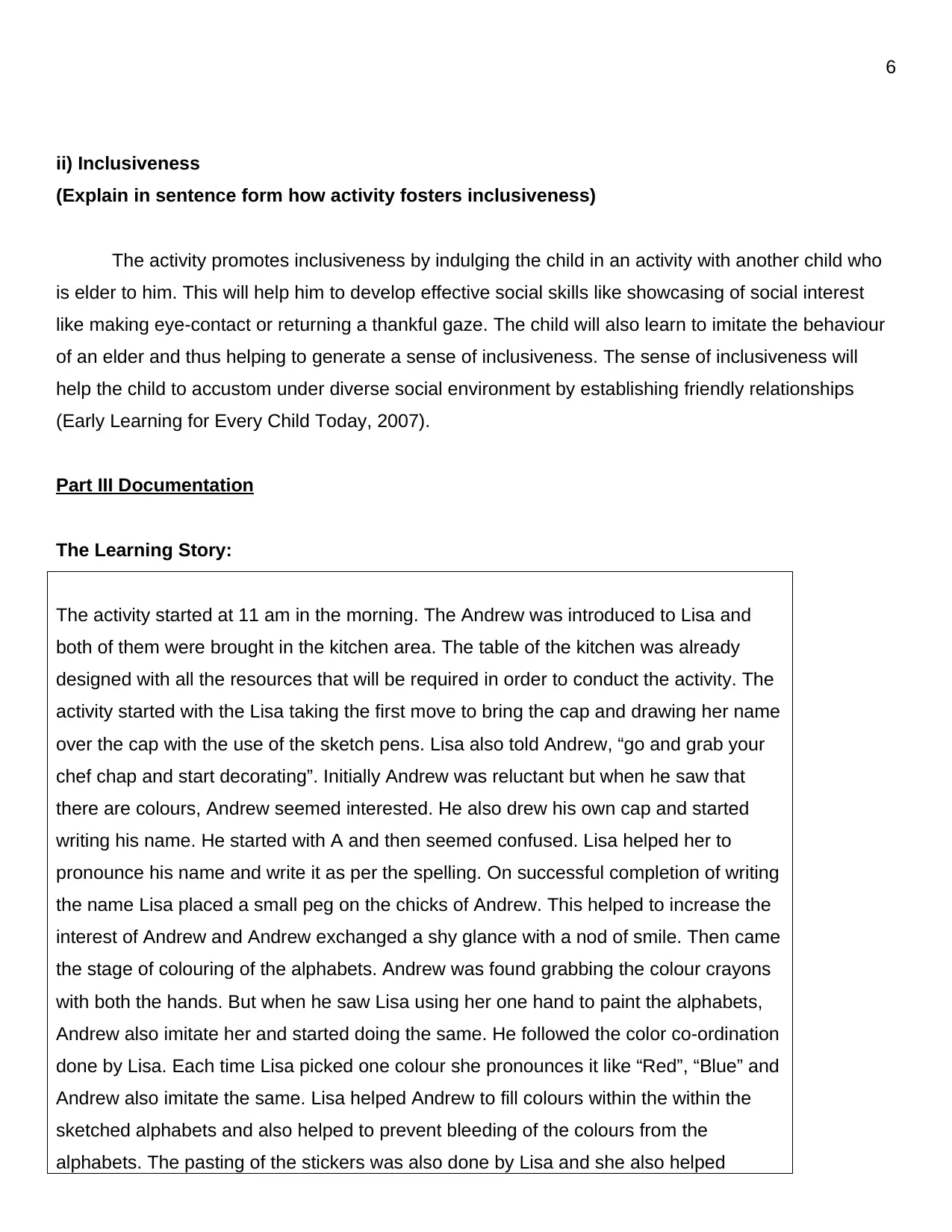
ii) Inclusiveness
(Explain in sentence form how activity fosters inclusiveness)
The activity promotes inclusiveness by indulging the child in an activity with another child who
is elder to him. This will help him to develop effective social skills like showcasing of social interest
like making eye-contact or returning a thankful gaze. The child will also learn to imitate the behaviour
of an elder and thus helping to generate a sense of inclusiveness. The sense of inclusiveness will
help the child to accustom under diverse social environment by establishing friendly relationships
(Early Learning for Every Child Today, 2007).
Part III Documentation
The Learning Story:
The activity started at 11 am in the morning. The Andrew was introduced to Lisa and
both of them were brought in the kitchen area. The table of the kitchen was already
designed with all the resources that will be required in order to conduct the activity. The
activity started with the Lisa taking the first move to bring the cap and drawing her name
over the cap with the use of the sketch pens. Lisa also told Andrew, “go and grab your
chef chap and start decorating”. Initially Andrew was reluctant but when he saw that
there are colours, Andrew seemed interested. He also drew his own cap and started
writing his name. He started with A and then seemed confused. Lisa helped her to
pronounce his name and write it as per the spelling. On successful completion of writing
the name Lisa placed a small peg on the chicks of Andrew. This helped to increase the
interest of Andrew and Andrew exchanged a shy glance with a nod of smile. Then came
the stage of colouring of the alphabets. Andrew was found grabbing the colour crayons
with both the hands. But when he saw Lisa using her one hand to paint the alphabets,
Andrew also imitate her and started doing the same. He followed the color co-ordination
done by Lisa. Each time Lisa picked one colour she pronounces it like “Red”, “Blue” and
Andrew also imitate the same. Lisa helped Andrew to fill colours within the within the
sketched alphabets and also helped to prevent bleeding of the colours from the
alphabets. The pasting of the stickers was also done by Lisa and she also helped
6
(Explain in sentence form how activity fosters inclusiveness)
The activity promotes inclusiveness by indulging the child in an activity with another child who
is elder to him. This will help him to develop effective social skills like showcasing of social interest
like making eye-contact or returning a thankful gaze. The child will also learn to imitate the behaviour
of an elder and thus helping to generate a sense of inclusiveness. The sense of inclusiveness will
help the child to accustom under diverse social environment by establishing friendly relationships
(Early Learning for Every Child Today, 2007).
Part III Documentation
The Learning Story:
The activity started at 11 am in the morning. The Andrew was introduced to Lisa and
both of them were brought in the kitchen area. The table of the kitchen was already
designed with all the resources that will be required in order to conduct the activity. The
activity started with the Lisa taking the first move to bring the cap and drawing her name
over the cap with the use of the sketch pens. Lisa also told Andrew, “go and grab your
chef chap and start decorating”. Initially Andrew was reluctant but when he saw that
there are colours, Andrew seemed interested. He also drew his own cap and started
writing his name. He started with A and then seemed confused. Lisa helped her to
pronounce his name and write it as per the spelling. On successful completion of writing
the name Lisa placed a small peg on the chicks of Andrew. This helped to increase the
interest of Andrew and Andrew exchanged a shy glance with a nod of smile. Then came
the stage of colouring of the alphabets. Andrew was found grabbing the colour crayons
with both the hands. But when he saw Lisa using her one hand to paint the alphabets,
Andrew also imitate her and started doing the same. He followed the color co-ordination
done by Lisa. Each time Lisa picked one colour she pronounces it like “Red”, “Blue” and
Andrew also imitate the same. Lisa helped Andrew to fill colours within the within the
sketched alphabets and also helped to prevent bleeding of the colours from the
alphabets. The pasting of the stickers was also done by Lisa and she also helped
6
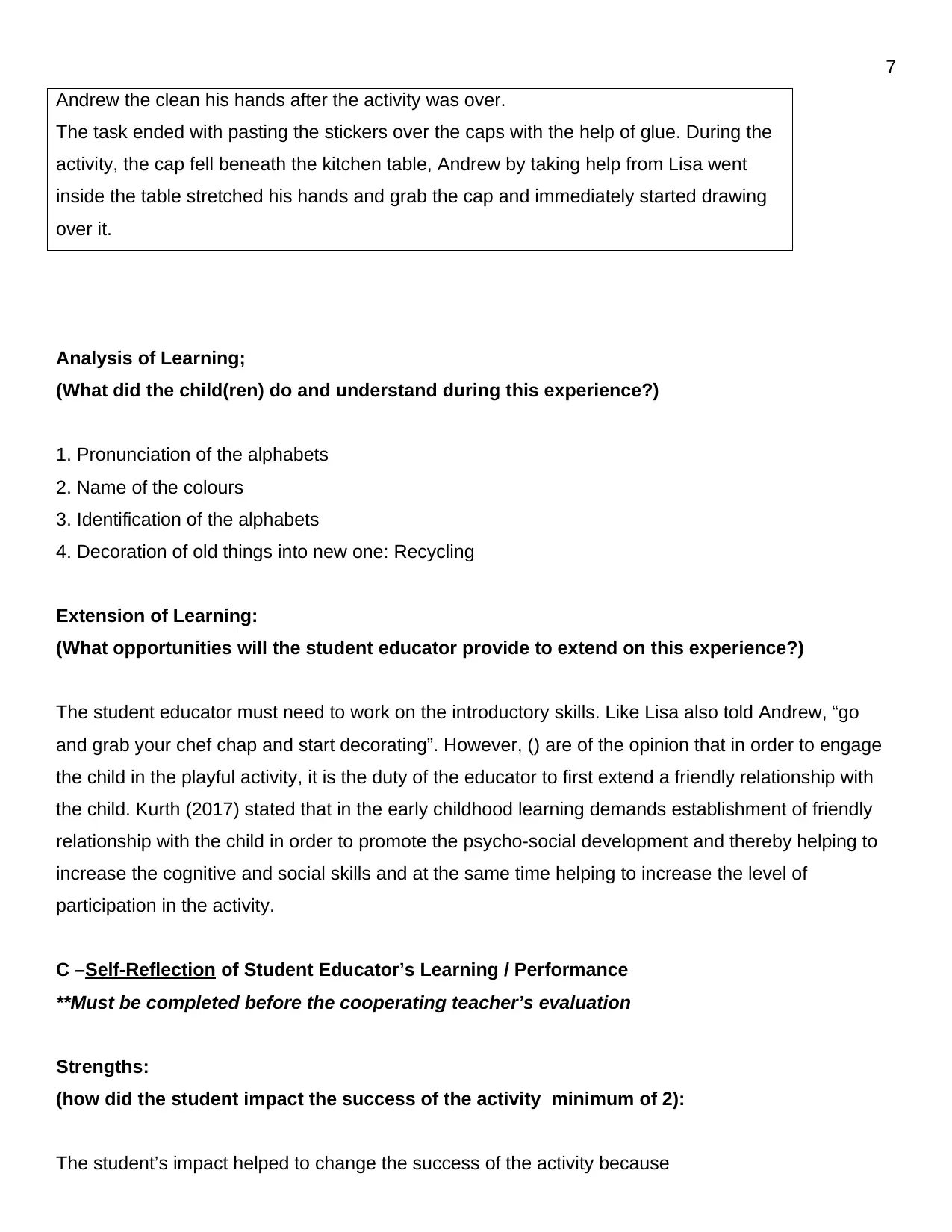
Andrew the clean his hands after the activity was over.
The task ended with pasting the stickers over the caps with the help of glue. During the
activity, the cap fell beneath the kitchen table, Andrew by taking help from Lisa went
inside the table stretched his hands and grab the cap and immediately started drawing
over it.
Analysis of Learning;
(What did the child(ren) do and understand during this experience?)
1. Pronunciation of the alphabets
2. Name of the colours
3. Identification of the alphabets
4. Decoration of old things into new one: Recycling
Extension of Learning:
(What opportunities will the student educator provide to extend on this experience?)
The student educator must need to work on the introductory skills. Like Lisa also told Andrew, “go
and grab your chef chap and start decorating”. However, () are of the opinion that in order to engage
the child in the playful activity, it is the duty of the educator to first extend a friendly relationship with
the child. Kurth (2017) stated that in the early childhood learning demands establishment of friendly
relationship with the child in order to promote the psycho-social development and thereby helping to
increase the cognitive and social skills and at the same time helping to increase the level of
participation in the activity.
C –Self-Reflection of Student Educator’s Learning / Performance
**Must be completed before the cooperating teacher’s evaluation
Strengths:
(how did the student impact the success of the activity minimum of 2):
The student’s impact helped to change the success of the activity because
7
The task ended with pasting the stickers over the caps with the help of glue. During the
activity, the cap fell beneath the kitchen table, Andrew by taking help from Lisa went
inside the table stretched his hands and grab the cap and immediately started drawing
over it.
Analysis of Learning;
(What did the child(ren) do and understand during this experience?)
1. Pronunciation of the alphabets
2. Name of the colours
3. Identification of the alphabets
4. Decoration of old things into new one: Recycling
Extension of Learning:
(What opportunities will the student educator provide to extend on this experience?)
The student educator must need to work on the introductory skills. Like Lisa also told Andrew, “go
and grab your chef chap and start decorating”. However, () are of the opinion that in order to engage
the child in the playful activity, it is the duty of the educator to first extend a friendly relationship with
the child. Kurth (2017) stated that in the early childhood learning demands establishment of friendly
relationship with the child in order to promote the psycho-social development and thereby helping to
increase the cognitive and social skills and at the same time helping to increase the level of
participation in the activity.
C –Self-Reflection of Student Educator’s Learning / Performance
**Must be completed before the cooperating teacher’s evaluation
Strengths:
(how did the student impact the success of the activity minimum of 2):
The student’s impact helped to change the success of the activity because
7
Paraphrase This Document
Need a fresh take? Get an instant paraphrase of this document with our AI Paraphraser
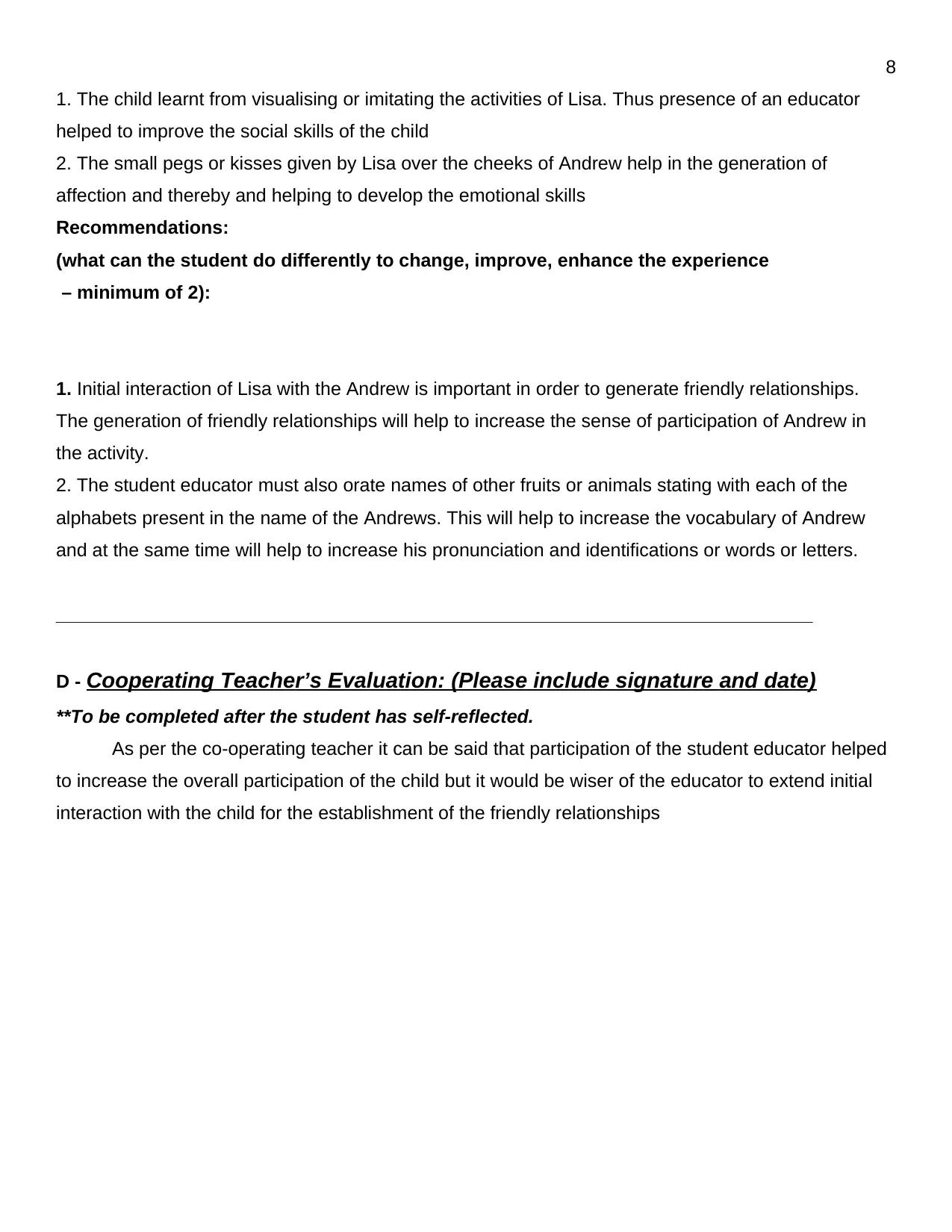
1. The child learnt from visualising or imitating the activities of Lisa. Thus presence of an educator
helped to improve the social skills of the child
2. The small pegs or kisses given by Lisa over the cheeks of Andrew help in the generation of
affection and thereby and helping to develop the emotional skills
Recommendations:
(what can the student do differently to change, improve, enhance the experience
– minimum of 2):
1. Initial interaction of Lisa with the Andrew is important in order to generate friendly relationships.
The generation of friendly relationships will help to increase the sense of participation of Andrew in
the activity.
2. The student educator must also orate names of other fruits or animals stating with each of the
alphabets present in the name of the Andrews. This will help to increase the vocabulary of Andrew
and at the same time will help to increase his pronunciation and identifications or words or letters.
_________________________________________________________________________
D - Cooperating Teacher’s Evaluation: (Please include signature and date)
**To be completed after the student has self-reflected.
As per the co-operating teacher it can be said that participation of the student educator helped
to increase the overall participation of the child but it would be wiser of the educator to extend initial
interaction with the child for the establishment of the friendly relationships
8
helped to improve the social skills of the child
2. The small pegs or kisses given by Lisa over the cheeks of Andrew help in the generation of
affection and thereby and helping to develop the emotional skills
Recommendations:
(what can the student do differently to change, improve, enhance the experience
– minimum of 2):
1. Initial interaction of Lisa with the Andrew is important in order to generate friendly relationships.
The generation of friendly relationships will help to increase the sense of participation of Andrew in
the activity.
2. The student educator must also orate names of other fruits or animals stating with each of the
alphabets present in the name of the Andrews. This will help to increase the vocabulary of Andrew
and at the same time will help to increase his pronunciation and identifications or words or letters.
_________________________________________________________________________
D - Cooperating Teacher’s Evaluation: (Please include signature and date)
**To be completed after the student has self-reflected.
As per the co-operating teacher it can be said that participation of the student educator helped
to increase the overall participation of the child but it would be wiser of the educator to extend initial
interaction with the child for the establishment of the friendly relationships
8
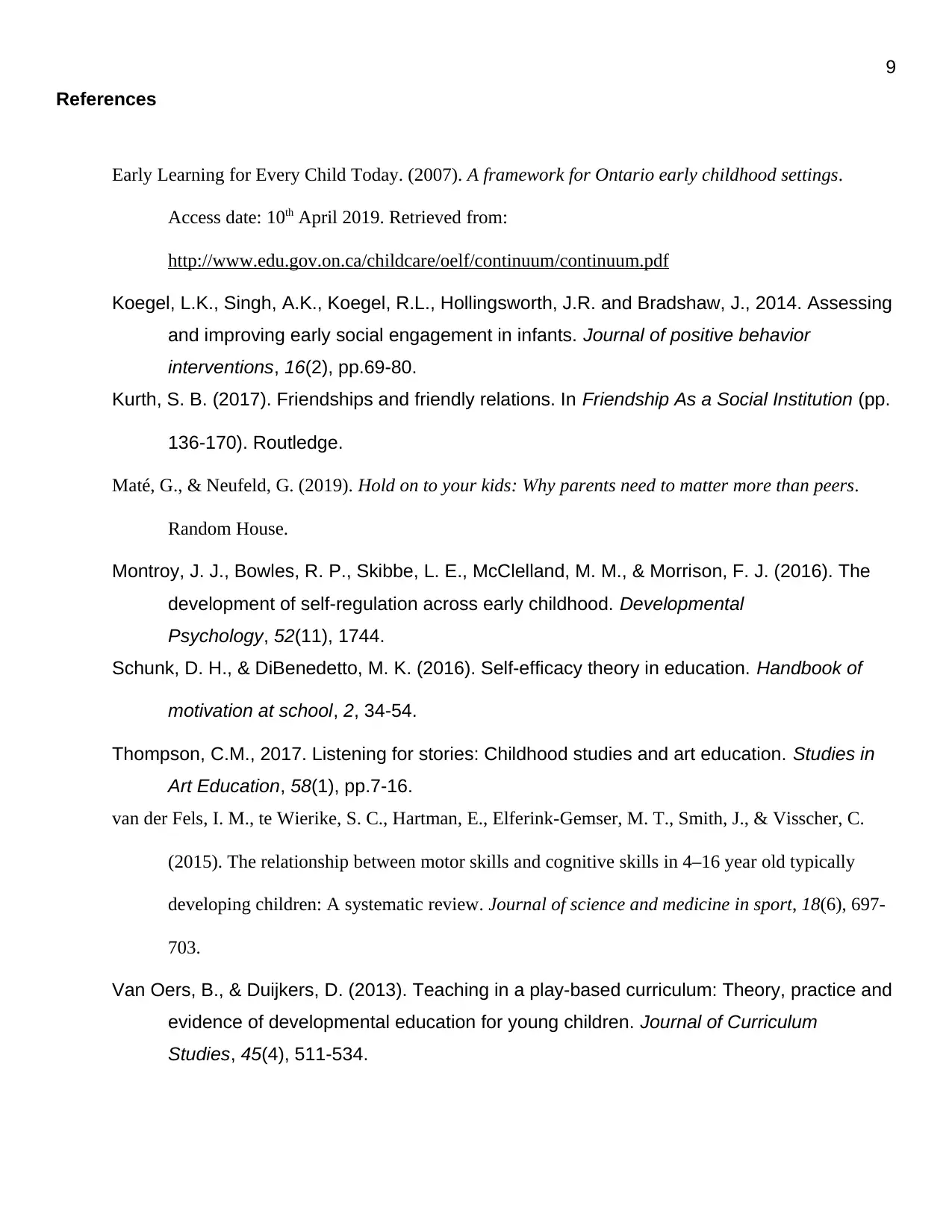
References
Early Learning for Every Child Today. (2007). A framework for Ontario early childhood settings.
Access date: 10th April 2019. Retrieved from:
http://www.edu.gov.on.ca/childcare/oelf/continuum/continuum.pdf
Koegel, L.K., Singh, A.K., Koegel, R.L., Hollingsworth, J.R. and Bradshaw, J., 2014. Assessing
and improving early social engagement in infants. Journal of positive behavior
interventions, 16(2), pp.69-80.
Kurth, S. B. (2017). Friendships and friendly relations. In Friendship As a Social Institution (pp.
136-170). Routledge.
Maté, G., & Neufeld, G. (2019). Hold on to your kids: Why parents need to matter more than peers.
Random House.
Montroy, J. J., Bowles, R. P., Skibbe, L. E., McClelland, M. M., & Morrison, F. J. (2016). The
development of self-regulation across early childhood. Developmental
Psychology, 52(11), 1744.
Schunk, D. H., & DiBenedetto, M. K. (2016). Self-efficacy theory in education. Handbook of
motivation at school, 2, 34-54.
Thompson, C.M., 2017. Listening for stories: Childhood studies and art education. Studies in
Art Education, 58(1), pp.7-16.
van der Fels, I. M., te Wierike, S. C., Hartman, E., Elferink-Gemser, M. T., Smith, J., & Visscher, C.
(2015). The relationship between motor skills and cognitive skills in 4–16 year old typically
developing children: A systematic review. Journal of science and medicine in sport, 18(6), 697-
703.
Van Oers, B., & Duijkers, D. (2013). Teaching in a play-based curriculum: Theory, practice and
evidence of developmental education for young children. Journal of Curriculum
Studies, 45(4), 511-534.
9
Early Learning for Every Child Today. (2007). A framework for Ontario early childhood settings.
Access date: 10th April 2019. Retrieved from:
http://www.edu.gov.on.ca/childcare/oelf/continuum/continuum.pdf
Koegel, L.K., Singh, A.K., Koegel, R.L., Hollingsworth, J.R. and Bradshaw, J., 2014. Assessing
and improving early social engagement in infants. Journal of positive behavior
interventions, 16(2), pp.69-80.
Kurth, S. B. (2017). Friendships and friendly relations. In Friendship As a Social Institution (pp.
136-170). Routledge.
Maté, G., & Neufeld, G. (2019). Hold on to your kids: Why parents need to matter more than peers.
Random House.
Montroy, J. J., Bowles, R. P., Skibbe, L. E., McClelland, M. M., & Morrison, F. J. (2016). The
development of self-regulation across early childhood. Developmental
Psychology, 52(11), 1744.
Schunk, D. H., & DiBenedetto, M. K. (2016). Self-efficacy theory in education. Handbook of
motivation at school, 2, 34-54.
Thompson, C.M., 2017. Listening for stories: Childhood studies and art education. Studies in
Art Education, 58(1), pp.7-16.
van der Fels, I. M., te Wierike, S. C., Hartman, E., Elferink-Gemser, M. T., Smith, J., & Visscher, C.
(2015). The relationship between motor skills and cognitive skills in 4–16 year old typically
developing children: A systematic review. Journal of science and medicine in sport, 18(6), 697-
703.
Van Oers, B., & Duijkers, D. (2013). Teaching in a play-based curriculum: Theory, practice and
evidence of developmental education for young children. Journal of Curriculum
Studies, 45(4), 511-534.
9
1 out of 9
Related Documents
Your All-in-One AI-Powered Toolkit for Academic Success.
+13062052269
info@desklib.com
Available 24*7 on WhatsApp / Email
![[object Object]](/_next/static/media/star-bottom.7253800d.svg)
Unlock your academic potential
© 2024 | Zucol Services PVT LTD | All rights reserved.





